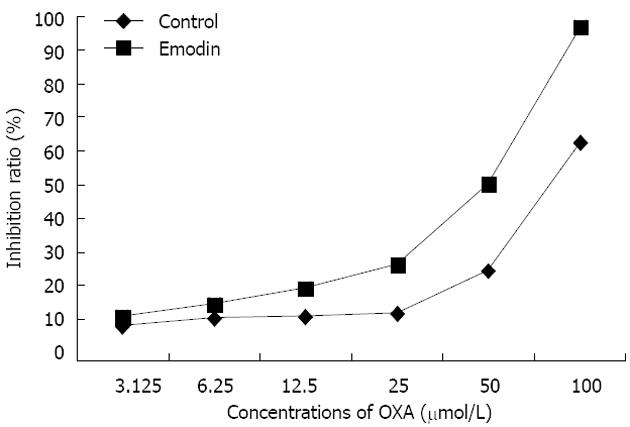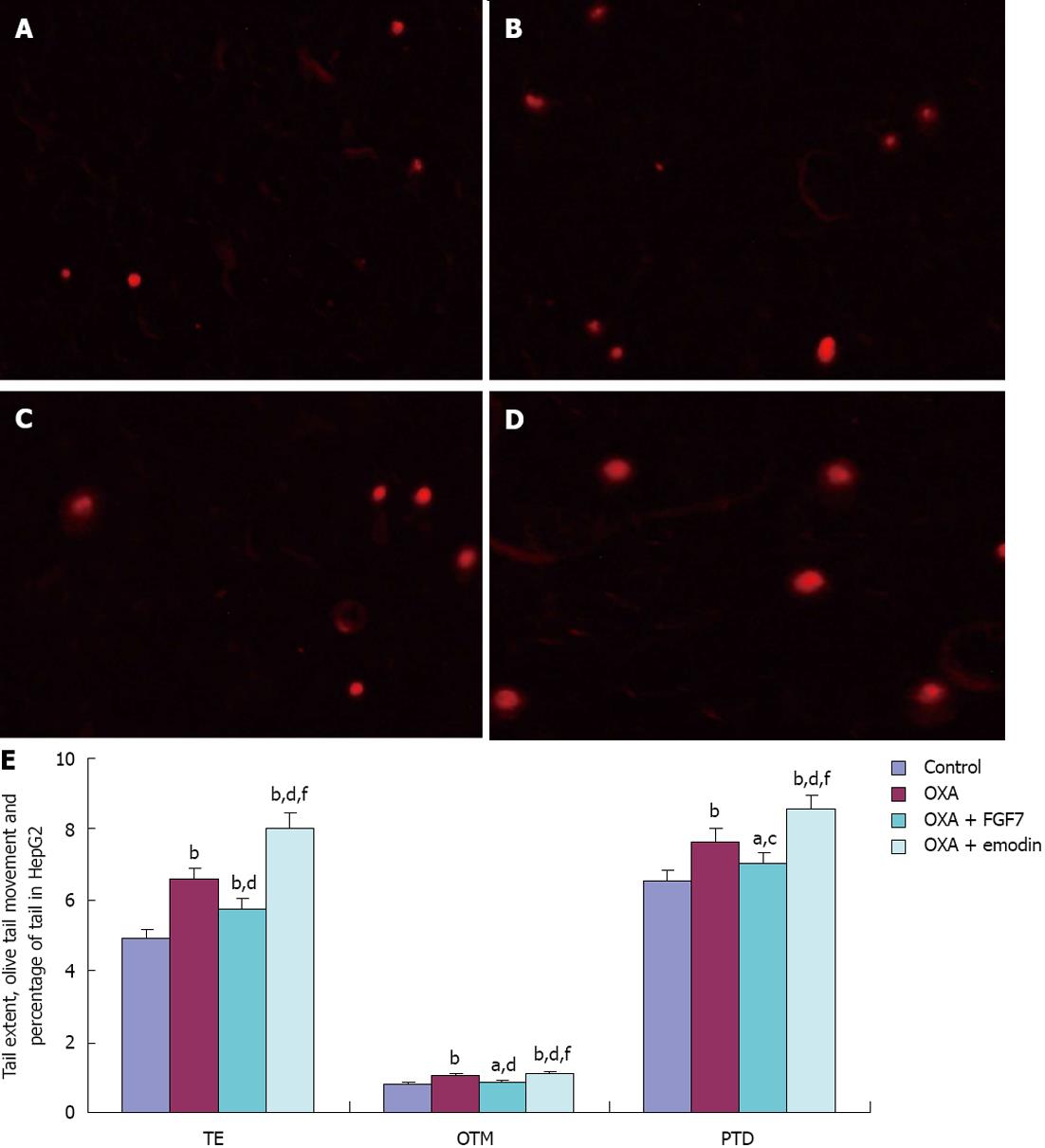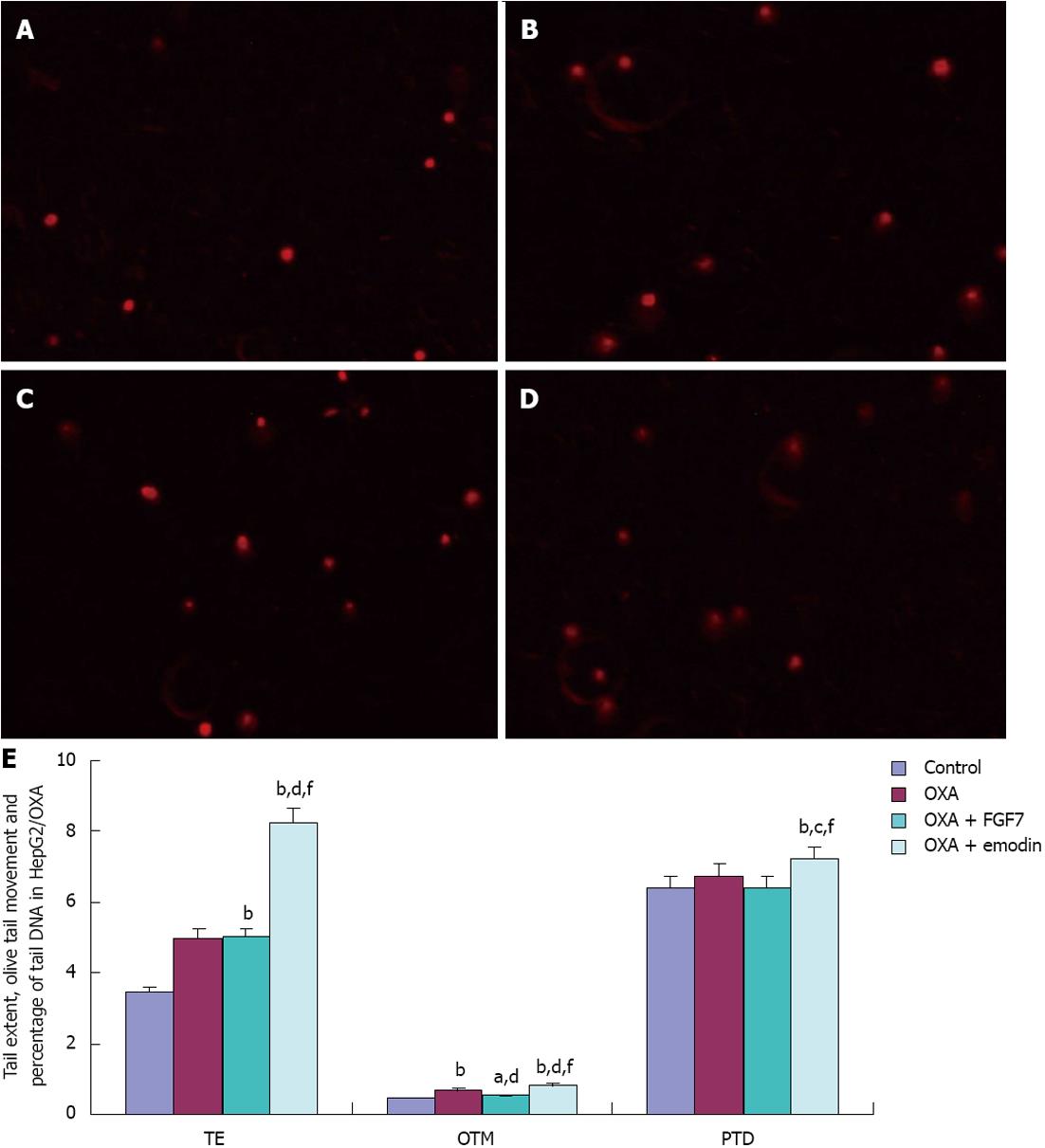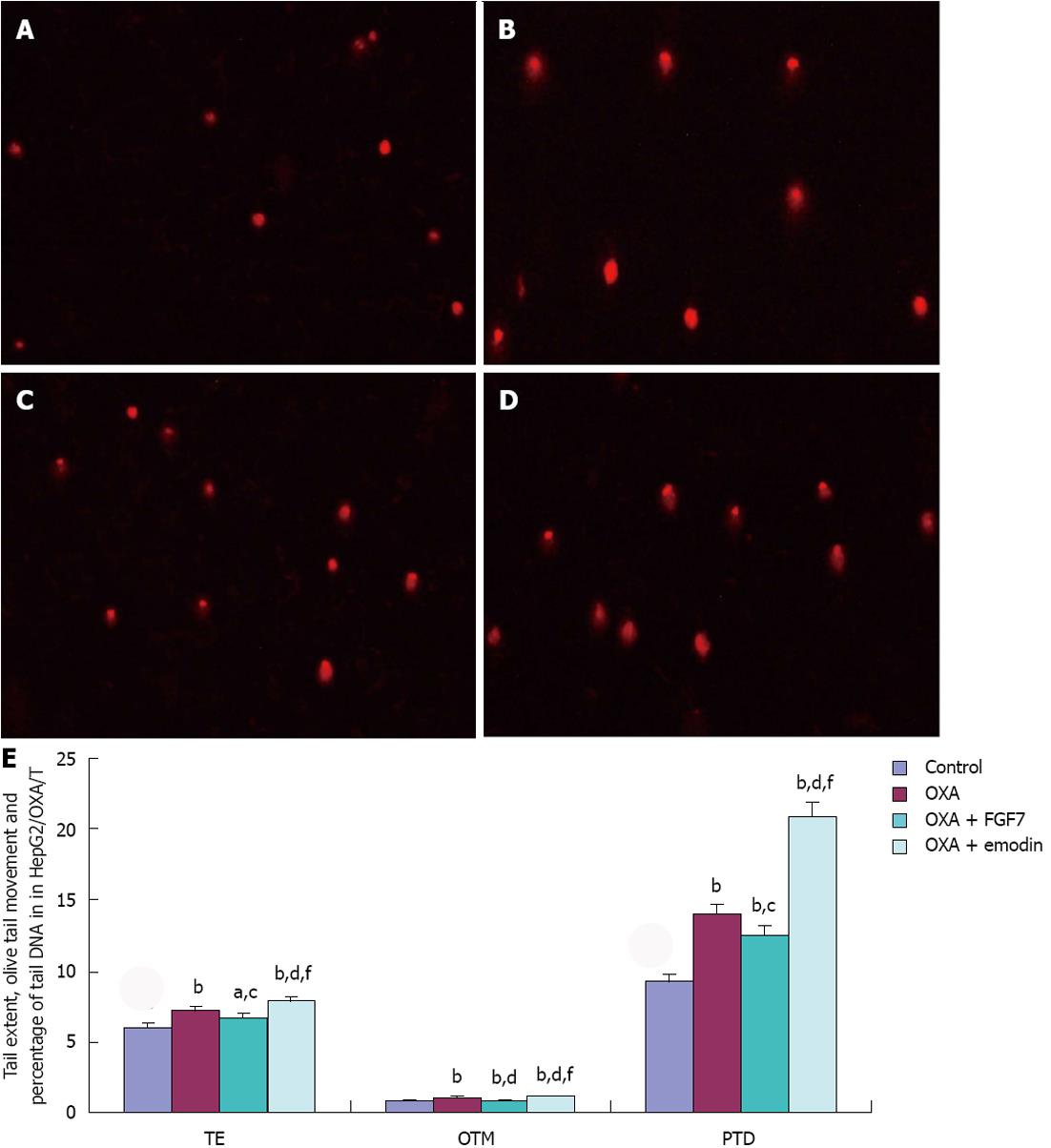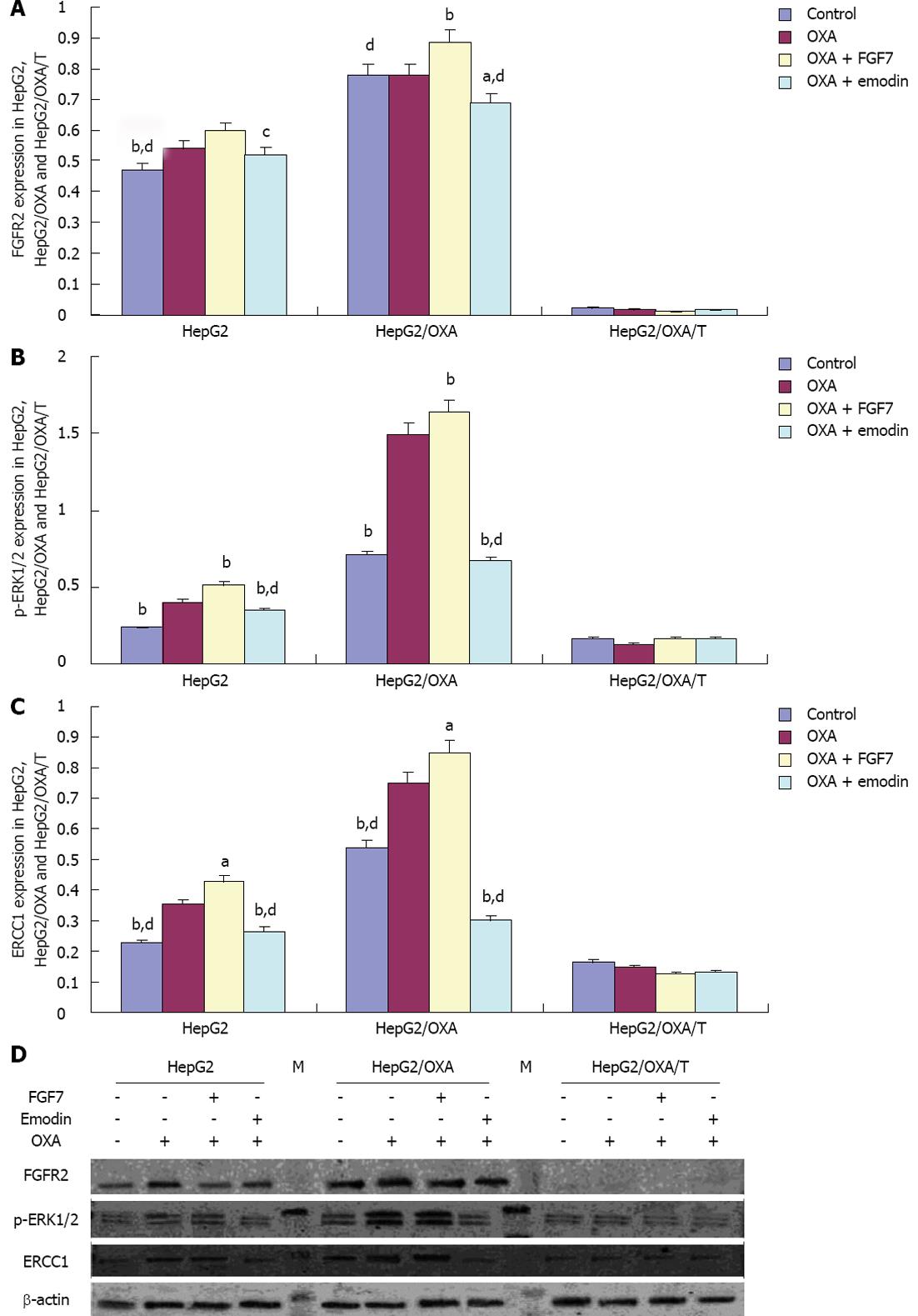Copyright
©2013 Baishideng Publishing Group Co.
World J Gastroenterol. Apr 28, 2013; 19(16): 2481-2491
Published online Apr 28, 2013. doi: 10.3748/wjg.v19.i16.2481
Published online Apr 28, 2013. doi: 10.3748/wjg.v19.i16.2481
Figure 1 Inhibition ratio of different concentrations (μmol/L) of oxaliplatin in HepG2/oxaliplatin cells.
The value of inhibition ratio increased steadily in the control group and the emodin group, which accompanied the elevated concentration of oxaliplatin (OXA) in the HepG2/OXA cells. However, the value of inhibition ratio in the emodin group treated with 10 μmol/L emodin was significantly higher in comparison with the control group.
Figure 2 DNA damage detected by single cell gel electrophoresis in HepG2.
A-D: Ethidium bromide stain (magnification × 200). Control group (A); Oxaliplatin (OXA) group (B); OXA + fibroblast growth factor 7 (FGF7) group (C); OXA + emodin group (D); E: The tail extent (TE), the Olive tail moment (OTM) and the percentage of tail DNA (PTD) were considerably increased in the OXA + emodin group in comparison with the OXA group and the OXA + FGF7 group, respectively, and these differences were statistically significant. TE, OTM and PTD were significantly lower in the OXA + FGF7 group compared with OXA + emodin group and OXA group; however, these values were higher than those of the control group (aP < 0.05, bP < 0.01 vs control group; cP < 0.05, dP < 0.01 vs OXA group; fP < 0.01 vs OXA + FGF7 group).
Figure 3 DNA damage detected by single cell gel electrophoresis in HepG2/oxaliplatin.
A-D: Ethidium bromide stain (magnification × 200). Control group (A); Oxaliplatin (OXA) group (B); OXA + fibroblast growth factor 7 (FGF7) group (C); OXA + emodin group (D); E: The tail extent (TE), the Olive tail moment (OTM) and the percentage of tail DNA (PTD) were considerably increased in the OXA + emodin group in comparison with the OXA group and the OXA + FGF group, respectively, and these differences were statistically significant. As for PTD there was no significant difference between the OXA group and the OXA + FGF7 group (aP < 0.05, bP < 0.01 vs control group; cP < 0.05, dP < 0.01 vs OXA group; fP < 0.01 vs OXA + FGF7 group).
Figure 4 DNA damage detected by single cell gel electrophoresis in HepG2/oxaliplatin/T.
A-D: Ethidium bromide stain (magnification × 200). Control group (A), Oxaliplatin (OXA) group (B), OXA + fibroblast growth factor 7 (FGF7) group (C), OXA + emodin group (D); E: The tail extent (TE), the Olive tail moment (OTM) and the percentage of tail DNA (PTD) were considerably increased in the OXA + emodin group in comparison with the OXA group and the OXA + FGF7 group, respectively, and these differences were statistically significant. TE, OTM and PTD were significantly decreased in the OXA + FGF7 group in comparison to those in the OXA group and the OXA + FGF7 group, but were greater than those in the control group (aP < 0.05, bP < 0.01 vs control group; cP < 0.05, dP < 0.01 vs OXA group; fP < 0.01 vs OXA + FGF7 group).
Figure 5 Comparison of fibroblast growth factor receptor 2, phosphorylated extracellular signal-regulated kinase 1/2, excision repair cross-complementing gene 1 expression in HepG2, HepG2/oxaliplatin and HepG2/oxaliplatin/T detected by Western blotting.
A-C: In comparison with in the parental HepG2 cell line, the expression levels of the fibroblast growth factor receptor 2 (FGFR2), phosphorylated extracellular signal-regulated kinase 1/2 (pERK1/2) and excision repair cross-complementing gene 1 (ERCC1) in the resistant cell line HepG2/oxaliplatin (OXA) were significantly increased, however, the pERK1/2 and ERCC1 expression levels in HepG2/OXA/T cells were significantly inhibited, as FGFR2 expression was silenced. The expression levels of pERK1/2 and ERCC1 in the HepG2 cells and that of FGFR2, pERK1/2 and ERCC1 in HepG2/OXA cells, was increased in the OXA + fibroblast growth factor 7 (FGF7) group and decreased in the OXA + emodin group with statistical significance compared with the OXA group, but the trend of those significant differences disappeared in HepG2/OXA/T cells (aP < 0.05, bP < 0.01 vs OXA group; cP < 0.05, dP < 0.01 vs OXA + FGF7 group); D: Western blotting of FGFR2, pERK1/2, ERCC1 in HepG2, HepG2/oxaliplatin and HepG2/oxaliplatin/T. M: Marker.
- Citation: Chen G, Qiu H, Ke SD, Hu SM, Yu SY, Zou SQ. Emodin regulating excision repair cross-complementation group 1 through fibroblast growth factor receptor 2 signaling. World J Gastroenterol 2013; 19(16): 2481-2491
- URL: https://www.wjgnet.com/1007-9327/full/v19/i16/2481.htm
- DOI: https://dx.doi.org/10.3748/wjg.v19.i16.2481













